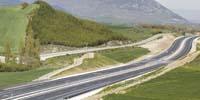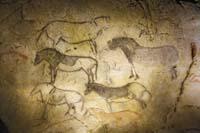Landscape transformation from the cult of nature

When listening to the word landscape, we often represent a bucolic and attractive landscape. We take a photo with mountains, sea... But also pavilions, factories, etc. are part of the landscape. In fact, the landscape is the totality of the parts of the territory that we perceive human beings, and every human activity influences its aspect. For example, if we go to the forest and observe a beech with a thick trunk and numerous ascending branches, don't think it looks like that by chance. No. That is not any payment. It is a beech that in its day had a special management for a certain purpose, so it has been given that aspect or pruning that has.
In short, the objectives of human activities or, what is the same, the economy of the time have designed the landscape from the Magdalenian to the present.
Changing look over the centuries

In the evolution of the landscape of Euskal Herria it can be said that there are three great golden epochs: Magdalenian, XVI. 20th century. The relationship between human beings and nature has been varied over the centuries, as evidenced by the work of landscape artists. "We have passed from one end to another. Specifically, the cult of nature. The man of the Magdalenian adorned nature, was something above all and man was only a small part of nature", explains Errekondo. Proof of this are the caves of Ekain, Lascaux and Altamira, among others. On the walls are images of Ekain horses, cows in Lascaux and bison in Altamira.
Instead of worshiping nature, man began to dominate the Neolithic. With agriculture, relations between man and nature began to change radically. They began to burn the forest, to make fields of cultivation, they domesticated the animals... In other words, they put nature at the service of man, a situation in which we are.
Later, the human groups knew the plants and techniques that came from the hand of the Romans. The Romans brought mainly wheat, grapes and olive trees.

XVI. Towards the 20th century, the inhabitants of that time began to colonize nature through the hamlets. "In any case, let's not think that at that time the hamlets were a nice family home. The hamlet is born as a building or cider factory. It was a breakthrough, as it was the transition from domestic cider production to fully industrial production," explained Galdós. Cider was the drink that drank the industrial society of the time. He did not drink water. No one drank water. It was not because they liked alcohol, but because they believed that water was a means of transmitting diseases. "The water was harmful to health, the wine was far and expensive and they had the apple at hand. They also mastered the cider technique. Therefore, for them the cider of the whole year was fundamental to survive," added Galdos. "If at that time we had looked from a plane, a quarter of Gipuzkoa was going to be an apple tree."
Like now, they were mixed hamlets: those who lived there, besides the work of the hamlet, also had outside it. "Euskalduna is not a farmer, it is urban long before the peasant," says Galdos. Baserritarra has lived in the hamlet, but it has always been related to commercial and industrial society, especially in the Atlantic spill, since its lands have not allowed to live alone with it. The Atlantic spill has been very poor from the agricultural point of view. The situation is different on the Mediterranean side. They have been good lands and grapes, wheat and olive trees have allowed their inhabitants to live off the land and wealth. Therefore, the landscape is completely different, and for many centuries the structure and nature of the landscape has not undergone drastic changes, even though it is now relatively transformed with the development of industrialization and communication infrastructures.
XVI-XVII. In the eighteenth century the Basque Country was totally industrial, but with the decline of the Spanish empire entered into crisis, emptying the urban centers and looking back at the land. In fact, one of the few possibilities of life was laboreo. In that time of crisis they bring from America an almost magical plant: corn. It easily adapted to the ecological conditions of our landscape, could be produced in precarious lands where wheat could not be grown, which gave seven times more. More and more land was colonized, villages were built everywhere...

XIX. At the end of the 20th century Euskal Herria returned to the industrial path. Pine became the star of forests, due to its rapid growth and easy industrial use, among others, in the paper sector. And XX. In the eighteenth century there was a strong industrialization, until the destruction of nature itself. This situation changed the landscape overnight. Since then, the landscape around us has been filled with infrastructure. The roads have been the ones that have occupied the terrain the most and have shaped the current landscape. "Although for centuries human beings have exploited and reduced forests, we have now gone further and are destroying the land itself, the base of the forest. We are breaking mountains to build tunnels, roads, etc. say the two experts. That is the current reality.
The future forest dress
And what in the future? What comes to us? It is the same as we have asked the experts, who have responded together: "The future is the forest. The forest has always been the basis of the economy, generating raw materials and energy." They say it will remain in the future. Therefore, it is essential to decide on the design of the forest in this urban society. In this urban society industry is no longer so important, services have taken hold. And services need communication. Therefore, the future landscape will focus mainly on communication infrastructures. It is a landscape based on cable, satellite, fiber optic and highway communication.

We must reflect on the benefits that the forest will report to this type of society. In fact, the forest will gradually gain strength. Gipuzkoa and Bizkaia remain, behind Finland, the territories with the highest proportion of forests. Errekondo and Galdos agree that in the near future forests should be used as an energy source. They consider that we must manage forests to generate biomass. Just as in the past the forest was designed with different types of trees to make coal, the challenge of the future is to analyze what kind of forests we need to produce biomass and how to manage it. If we want to maintain as heritage other types of meadows and meadows, we have to pay, since they can not keep wide and beautiful territories only for its aesthetic beauty. "However, some meadows will remain as sheep cheese is made at a good price," explains Errekondo.





